The Impact of Various Cockpit Display Interfaces on Novice Pilots’ Mental Workload and Situational Awareness: A Comparative Study
Abstract
1. Introduction
- RQ1:
- Do different designs of CDIs that provide the same information have different effects on a pilot’s SA?
- RQ2:
- What impact do different designs of CDIs with the same information have on pilots’ MWL?
2. Related Work
2.1. Situational Awareness and Mental Workload
2.2. Information Processing Models
3. Methods
3.1. Hypotheses
- HPSA (Operator’s SA)Under the same task difficulty, there will be a significant difference in SA between two different CDIs.
- HPMWL (Operator’s MWL)For the same task, the operator’s MWL will be significantly lower with a CDI that has a higher SA level than with a CDI that has a lower SA level.
3.2. Task
3.2.1. Primary Task
3.2.2. Secondary Task
- As the difficulty of the N-back task increased, the performance of the primary task degraded.
- As the difficulty of the N-back task increased, the MWL of the participants rose.
- Single flight;
- Flight + one-back task;
- Flight + two-back task.
3.3. Participants
3.4. Data Collection
3.5. Procedure
4. Results
4.1. Flight Performance
4.2. MWL Measures
4.2.1. HRV Data
4.2.2. EEG Data
The Band
The Band
The / Ratio
4.2.3. NASA-TLX Score
4.3. Limitations
5. Conclusions
Author Contributions
Funding
Institutional Review Board Statement
Informed Consent Statement
Data Availability Statement
Acknowledgments
Conflicts of Interest
References
- Li, W.; Li, R.; Xie, X.; Chang, Y. Evaluating mental workload during multitasking in simulated flight. Brain Behav. 2022, 12, e2489. [Google Scholar] [CrossRef] [PubMed]
- Wickens, C.D. Workload and situation awareness. In Stress, Workload, and Fatigue; Lawrence Erlbaum Associates, Inc.: Mahwah, NJ, USA, 2001; pp. 443–450. [Google Scholar]
- Cain, B. A Review of the Mental Workload Literature; Technical Report; Defence Research And Development Toronto (Canada): North York, ON, Canada, 2007. [Google Scholar]
- Wickens, C.D.; Hollands, J.G.; Banbury, S.; Parasuraman, R. Engineering Psychology and Human Performance; Psychology Press: London, UK, 2015; pp. 480–507. [Google Scholar]
- Endsley, M.R. Toward a theory of situation awareness in dynamic systems. Hum. Factors 1995, 37, 32–64. [Google Scholar] [CrossRef]
- Selcon, S.J.; Hardiman, T.D.; Croft, D.G.; Endsley, M.R. A Test-Battery Approach to Cognitive Engineering: To Meta-Measure or not to Meta-Measure, that is the Question! In Proceedings of the 40th Annual Meeting of Human Factors and Ergonomics Society, Santa Monica, CA, USA, 1 October 1996; SAGE Publications Sage CA: Los Angeles, CA, USA, 1996; Volume 40, pp. 228–232. [Google Scholar]
- Stanton, N.A.; Plant, K.L.; Roberts, A.P.; Allison, C.K. Use of Highways in the Sky and a virtual pad for landing Head Up Display symbology to enable improved helicopter pilots situation awareness and workload in degraded visual conditions. Ergonomics 2019, 62, 255–267. [Google Scholar] [CrossRef] [PubMed]
- Wei, H.; Zhuang, D.; Wanyan, X.; Wang, Q. An experimental analysis of situation awareness for cockpit display interface evaluation based on flight simulation. Chin. J. Aeronaut. 2013, 26, 884–889. [Google Scholar] [CrossRef]
- Yan, S.; Wei, Y.; Tran, C.C. Evaluation and prediction mental workload in user interface of maritime operations using eye response. Int. J. Ind. Ergon. 2019, 71, 117–127. [Google Scholar] [CrossRef]
- Feng, C.; Wanyan, X.; Liu, S.; Chen, H.; Zhuang, D. An approach to situation awareness (SA) assessment in flight simulation: SA dynamic circulation (SADC) model. Hum. Factors Ergon. Manuf. Serv. Ind. 2021, 31, 559–569. [Google Scholar] [CrossRef]
- Casner, S.M. Perceived vs. measured effects of advanced cockpit systems on pilot workload and error: Are pilots’ beliefs misaligned with reality? Appl. Ergon. 2009, 40, 448–456. [Google Scholar] [CrossRef] [PubMed]
- Beringer, D.B.; Ball, J.D. A comparison of pilot navigation performance using conventional instrumentation, head-down, and head-up highway-in-the-sky primary flight displays. In Proceedings of the Human Factors and Ergonomics Society 45th Annual Meeting, Minneapolis, MN, USA, 8–12 October 2001; SAGE Publications Sage CA: Los Angeles, CA, USA, 2001; Volume 45, pp. 16–20. [Google Scholar]
- Wickens, C.D. Situation awareness and workload in aviation. Curr. Dir. Psychol. Sci. 2002, 11, 128–133. [Google Scholar] [CrossRef]
- Wickens, C.D. Multiple resources and performance prediction. Theor. Issues Ergon. Sci. 2002, 3, 159–177. [Google Scholar] [CrossRef]
- Sharples, S.; Megaw, T. The definition and measurement of human workload. Eval. Hum. Work. 2015, 516–544. [Google Scholar]
- Andre, A.D.; Wickens, C.D.; Moorman, L. Display formatting techniques for improving situation awareness in the aircraft cockpit. Int. J. Aviat. Psychol. 1991, 1, 205–218. [Google Scholar] [CrossRef]
- Wu, X.; Wanyan, X.; Zhuang, D.; Liu, S. Pilot situational awareness modeling for cockpit interface evaluation. In Proceedings of the International Conference on Engineering Psychology and Cognitive Ergonomics, Toronto, ON, Canada, 17–22 July 2016; Springer: Berlin/Heidelberg, Germany, 2016; pp. 476–484. [Google Scholar]
- Longo, L. Formalising Human Mental Workload as a Defeasible Computational Concept. Ph.D. Thesis, The University of Dublin, Trinity College, Ireland, 2014. [Google Scholar]
- Morris, C.H.; Leung, Y.K. Pilot mental workload: How well do pilots really perform? Ergonomics 2006, 49, 1581–1596. [Google Scholar] [CrossRef] [PubMed]
- Wei, Z.; Zhuang, D.; Wanyan, X.; Liu, C.; Zhuang, H. A model for discrimination and prediction of mental workload of aircraft cockpit display interface. Chin. J. Aeronaut. 2014, 27, 1070–1077. [Google Scholar] [CrossRef]
- Wilson, G.F. An analysis of mental workload in pilots during flight using multiple psychophysiological measures. Int. J. Aviat. Psychol. 2002, 12, 3–18. [Google Scholar] [CrossRef]
- Uenking, M.D.; Hughes, M.F. The Efficacy of using synthetic vision terrain-Textured images to improve pilot situation awareness. SAE Trans. 2002, 111, 572–583. [Google Scholar]
- Davis, R.C.; Wilt, D.W.; Henion, J.; Alter, K.; Snow, P.; Deaton, J.E. Formal tests for LLM approaches using refined cockpit display technology. In Enhanced and Synthetic Vision 2005; SPIE: Bellingham, WA, USA, 2005; Volume 5802, pp. 231–238. [Google Scholar]
- Lin, L.W.; Lu, M.S. Empirical research on the relationship between Helicopter Pilots’ mental workloads and situation awareness levels. J. Am. Helicopter Soc. 2016, 61, 1–8. [Google Scholar] [CrossRef]
- Wickens, C.D. Multiple resources and mental workload. Hum. Factors 2008, 50, 449–455. [Google Scholar] [CrossRef] [PubMed]
- Horrey, W.J.; Wickens, J.D. Multiple resource modeling of task interference in vehicle control, hazard awareness and in-vehicle task performance. In Proceedings of the Driving Assesment Conference, Park City, UT, USA, 21–24 July 2003; Volume 2, pp. 7–12. [Google Scholar]
- Wickens, C.D. Multiple resource time sharing models. In Handbook of Human Factors and Ergonomics Methods; CRC Press: Boca Raton, FL, USA, 2004; pp. 427–434. [Google Scholar]
- Ryu, K.; Myung, R. Evaluation of mental workload with a combined measure based on physiological indices during a dual task of tracking and mental arithmetic. Int. J. Ind. Ergon. 2005, 35, 991–1009. [Google Scholar] [CrossRef]
- Liggett, K.K.; Reising, J.M.; Hartsock, D.C. Development and evaluation of a background attitude indicator. Int. J. Aviat. Psychol. 1999, 9, 49–71. [Google Scholar] [CrossRef]
- Xiao, X.; Wanyan, X.; Zhuang, D. Mental workload prediction based on attentional resource allocation and information processing. Bio-Med. Mater. Eng. 2015, 26, S871–S879. [Google Scholar] [CrossRef]
- Thorpe, A.; Estival, D.; Molesworth, B.; Eidels, A. Pilot errors: Communication comes last. Saf. Sci. 2022, 149, 105686. [Google Scholar] [CrossRef]
- Rainieri, G.; Fraboni, F.; Russo, G.; Tul, M.; Pingitore, A.; Tessari, A.; Pietrantoni, L. Visual scanning techniques and mental workload of helicopter pilots during simulated flight. Aerosp. Med. Hum. Perform. 2021, 92, 11–19. [Google Scholar] [CrossRef] [PubMed]
- Endsley, M.R. Situation awareness. Handb. Hum. Factors Ergon. 2021, 434–455. [Google Scholar] [CrossRef]
- Grether, W.F. Instrument reading. I. The design of long-scale indicators for speed and accuracy of quantitative readings. J. Appl. Psychol. 1949, 33, 363. [Google Scholar] [CrossRef]
- Jaeggi, S.M.; Buschkuehl, M.; Perrig, W.J.; Meier, B. The concurrent validity of the N-back task as a working memory measure. Memory 2010, 18, 394–412. [Google Scholar] [CrossRef] [PubMed]
- Anderson, V.L.; McLean, R.A. Design of Experiments: A Realistic Approach; CRC Press: Boca Raton, FL, USA, 2018; Chapter 8. [Google Scholar]
- Lean, Y.; Shan, F. Brief review on physiological and biochemical evaluations of human mental workload. Hum. Factors Ergon. Manuf. Serv. Ind. 2012, 22, 177–187. [Google Scholar] [CrossRef]
- Hankins, T.C.; Wilson, G.F. A comparison of heart rate, eye activity, EEG and subjective measures of pilot mental workload during flight. Aviat. Space Environ. Med. 1998, 69, 360–367. [Google Scholar] [PubMed]
- Fink, A.; Grabner, R.; Neuper, C.; Neubauer, A. EEG alpha band dissociation with increasing task demands. Cogn. Brain Res. 2005, 24, 252–259. [Google Scholar] [CrossRef] [PubMed]
- Brouwer, A.M.; Hogervorst, M.A.; Van Erp, J.B.; Heffelaar, T.; Zimmerman, P.H.; Oostenveld, R. Estimating workload using EEG spectral power and ERPs in the n-back task. J. Neural Eng. 2012, 9, 045008. [Google Scholar] [CrossRef]
- Esposito, F.; Aragri, A.; Piccoli, T.; Tedeschi, G.; Goebel, R.; Di Salle, F. Distributed analysis of simultaneous EEG-fMRI time-series: Modeling and interpretation issues. Magn. Reson. Imaging 2009, 27, 1120–1130. [Google Scholar] [CrossRef]
- Jasper, H.H. The ten-twenty electrode system of the International Federation. Electroencephalogr. Clin. Neurophysiol. 1958, 10, 370–375. [Google Scholar]
- Jahn, N.T.; Meshi, D.; Bente, G.; Schmälzle, R. Media neuroscience on a shoestring: Examining electrocortical responses to visual stimuli via mobile EEG. J. Media Psychol. Theor. Methods Appl. 2022. [Google Scholar] [CrossRef]
- Pu, L.; Lion, K.M.; Todorovic, M.; Moyle, W. Portable EEG monitoring for older adults with dementia and chronic pain-A feasibility study. Geriatr. Nurs. 2021, 42, 124–128. [Google Scholar] [CrossRef] [PubMed]
- Jaiswal, D.; Chowdhury, A.; Banerjee, T.; Chatterjee, D. Effect of Mental Workload on Breathing Pattern and Heart Rate for a Working Memory Task: A Pilot Study. In Proceedings of the 2019 41st Annual International Conference of the IEEE Engineering in Medicine and Biology Society (EMBC), Berlin, Germany, 23–27 July 2019; IEEE: Piscataway, NJ, USA, 2019; pp. 2202–2206. [Google Scholar]
- Murai, K.; Hayashi, Y.; Okazaki, T.; Stone, L.C.; Mitomo, N. Evaluation of ship navigator’s mental workload using nasal temperature and heart rate variability. In Proceedings of the 2008 IEEE International Conference on Systems, Man and Cybernetics, Singapore, 12–15 October 2008; IEEE: Piscataway, NJ, USA, 2008; pp. 1528–1533. [Google Scholar]
- Murata, A. Experimental discussion on measurement of mental workload-evaluation of mental workload by HRV measures. IEICE Trans. Fundam. Electron. Commun. Comput. Sci. 1994, 77, 409–416. [Google Scholar]
- Chattopadhyay, S.; Das, R. Comparing heart rate variability with polar H10 sensor and pulse rate variability with LYFAS: A novel study. J. Biomed. Eng. Technol. 2021, 9, 1–9. [Google Scholar] [CrossRef]
- H-Aviation. Cessna 172S Skyhawk—FAQ’s. 2020. Available online: https://www.h-aviation.com/cessna-172s---skyhawk.html#:~:text=How%20fast%20does%20the%20Cessna,a%20maximum%20of%20302km%2Fh (accessed on 10 November 2020).
- Hart, S.G. NASA-task load index (NASA-TLX); 20 years later. In Proceedings of the Human Factors and Ergonomics Society Annual Meeting, San Fransisco, CA, USA, 16–20 October 2006; Sage Publications Sage CA: Los Angeles, CA, USA, 2006; Volume 50, pp. 904–908. [Google Scholar]
- Hart, S.G.; Staveland, L.E. Development of NASA-TLX (Task Load Index): Results of empirical and theoretical research. In Advances in Psychology; Elsevier: Amsterdam, The Netherlands, 1988; Volume 52, pp. 139–183. [Google Scholar]
- Shankar, S.; Singh, R. Demystifying statistics: How to choose a statistical test? Indian J. Rheumatol. 2014, 9, 77–81. [Google Scholar] [CrossRef]
- Khorana, A.; Pareek, A.; Ollivier, M.; Madjarova, S.J.; Kunze, K.N.; Nwachukwu, B.U.; Karlsson, J.; Marigi, E.M.; Williams III, R.J. Choosing the appropriate measure of central tendency: Mean, median, or mode? Knee Surgery Sport. Traumatol. Arthrosc. 2023, 31, 12–15. [Google Scholar] [CrossRef]
- Wickens, C.D. Attentional tunneling and task management. In Proceedings of the 2005 International Symposium on Aviation Psychology, Dayton, OH, USA, 18–21 April 2005; p. 812. [Google Scholar]
- Champseix, R. Hrv-Analysis, 2021. Version 1.0.4. Github. 2021. Available online: https://github.com/Aura-healthcare/hrv-analysis (accessed on 4 November 2020).
- Veltman, J.; Gaillard, A. Physiological workload reactions to increasing levels of task difficulty. Ergonomics 1998, 41, 656–669. [Google Scholar] [CrossRef] [PubMed]
- Yao, D.; Wang, L.; Oostenveld, R.; Nielsen, K.D.; Arendt-Nielsen, L.; Chen, A.C. A comparative study of different references for EEG spectral mapping: The issue of the neutral reference and the use of the infinity reference. Physiol. Meas. 2005, 26, 173. [Google Scholar] [CrossRef]
- Mallat, S.G. A theory for multiresolution signal decomposition: The wavelet representation. IEEE Trans. Pattern Anal. Mach. Intell. 1989, 11, 674–693. [Google Scholar] [CrossRef]
- Hazarika, N.; Chen, J.Z.; Tsoi, A.C.; Sergejew, A. Classification of EEG signals using the wavelet transform. Signal Process. 1997, 59, 61–72. [Google Scholar] [CrossRef]
- Tsang, P.; Psychologist, M. Mental Workload and Situation Awareness; Wiley: Hoboken, NJ, USA, 2006; Chapter 9; pp. 243–268. [Google Scholar]
- Napierala, M.A. What is the Bonferroni correction? Aaos Now 2012, 40–41. Available online: http://www.aaos.org/news/aaosnow/apr12/research7.asp (accessed on 6 June 2022).
- Kandel, E.R.; Schwartz, J.H.; Jessell, T.M.; Siegelbaum, S.; Hudspeth, A.J.; Mack, S. Principles of Neural Science, 6th ed.; McGraw-Hill: New York, NY, USA, 2021; p. 1450. [Google Scholar]
- Pritschet, L.; Powell, D.; Horne, Z. Marginally significant effects as evidence for hypotheses: Changing attitudes over four decades. Psychol. Sci. 2016, 27, 1036–1042. [Google Scholar] [CrossRef] [PubMed]
- Stipacek, A.; Grabner, R.; Neuper, C.; Fink, A.; Neubauer, A. Sensitivity of human EEG alpha band desynchronization to different working memory components and increasing levels of memory load. Neurosci. Lett. 2003, 353, 193–196. [Google Scholar] [CrossRef] [PubMed]
- Iqbal, S.T.; Zheng, X.S.; Bailey, B.P. Task-evoked pupillary response to mental workload in human-computer interaction. In Proceedings of the CHI’04 Extended Abstracts on Human Factors in Computing Systems, Vienna, Austria, 24–29 April 2004; pp. 1477–1480. [Google Scholar]
- Marquart, G.; Cabrall, C.; De Winter, J. Review of eye-related measures of drivers’ mental workload. Procedia Manuf. 2015, 3, 2854–2861. [Google Scholar] [CrossRef]
- Jacob, R.J. Eye tracking in advanced interface design. Virtual Environ. Adv. Interface Des. 1995, 258, 2. [Google Scholar]
- Poole, A.; Ball, L.J. Eye tracking in HCI and usability research. In Encyclopedia of Human Computer Interaction; IGI Global: Hershey, PA, USA, 2006; pp. 211–219. [Google Scholar]
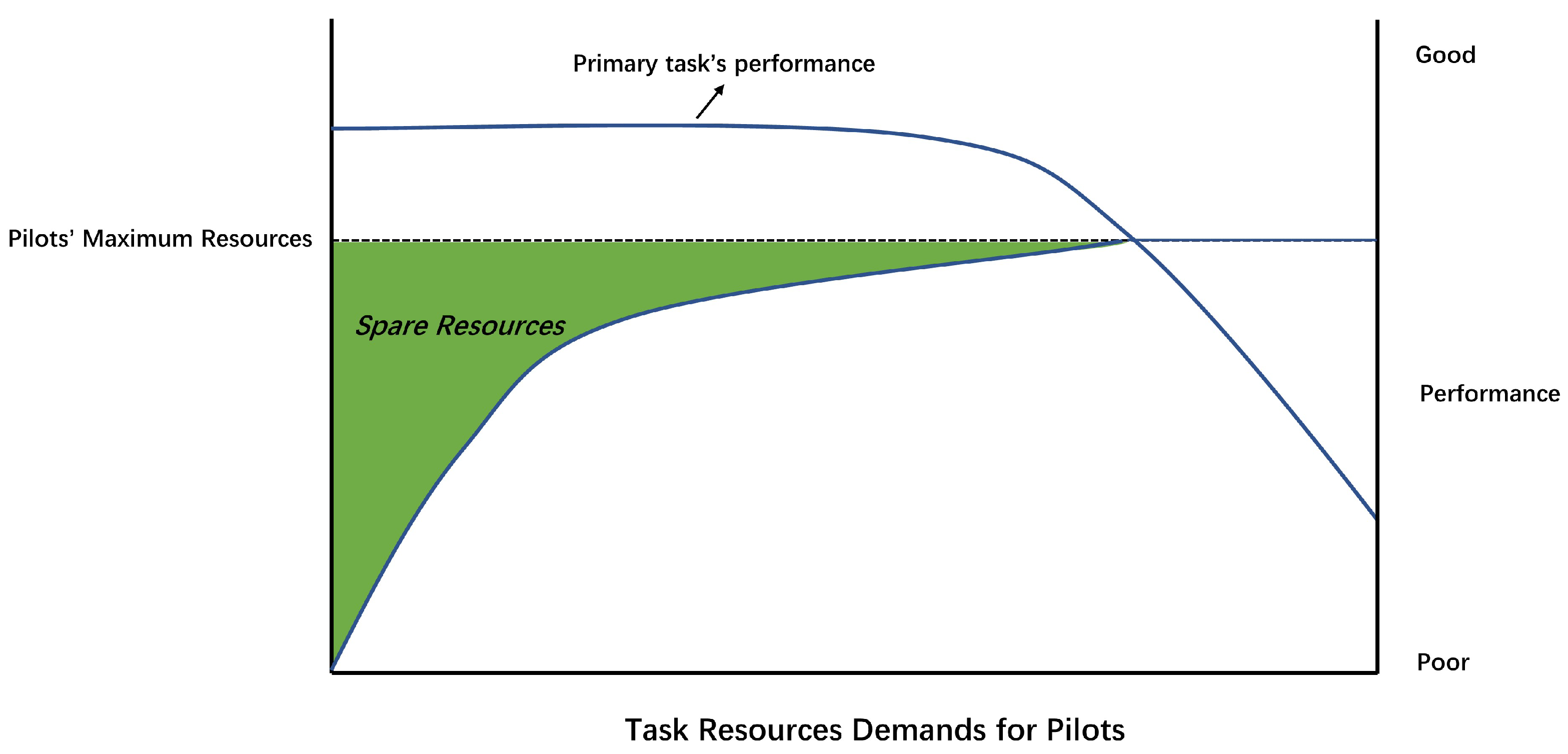
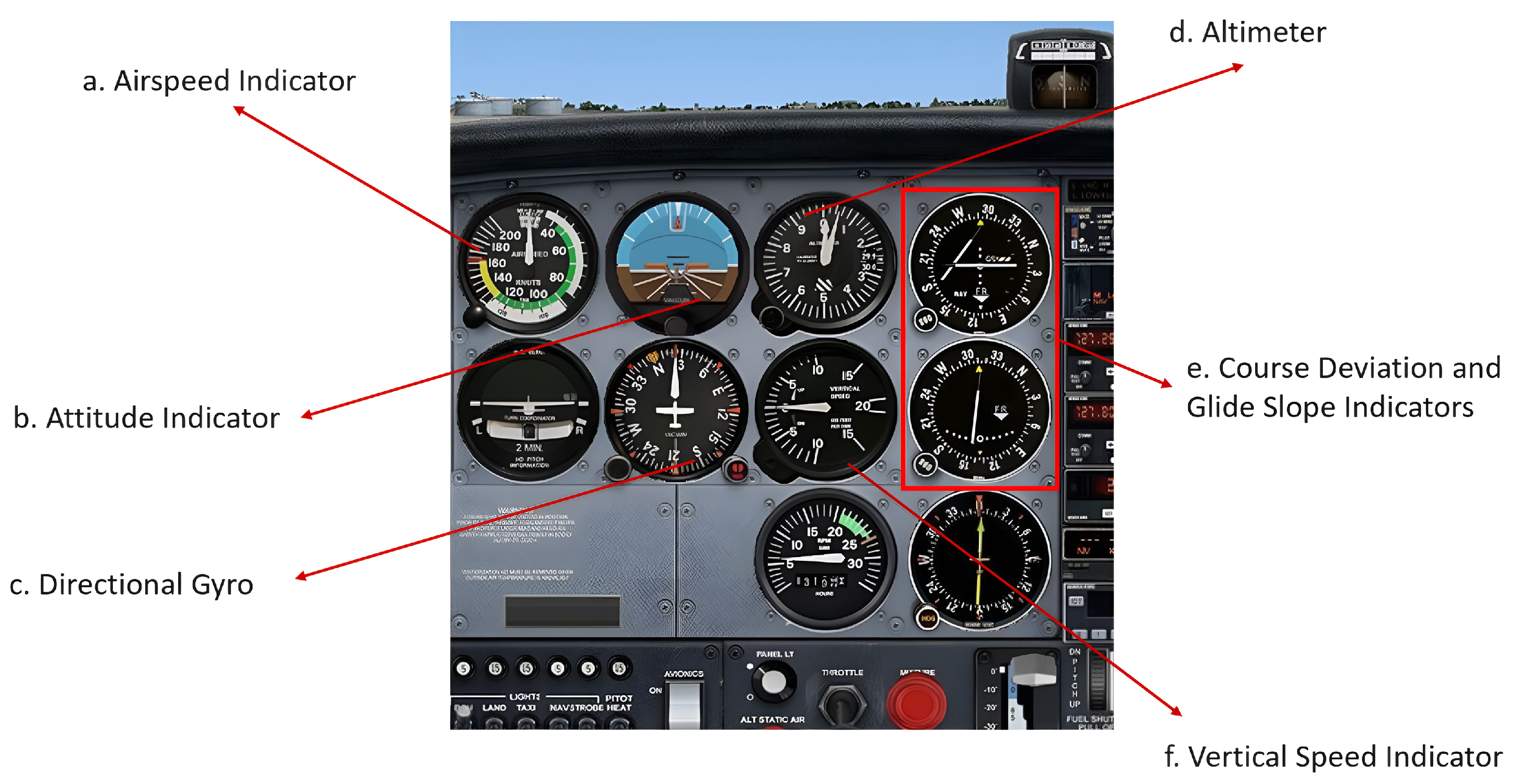
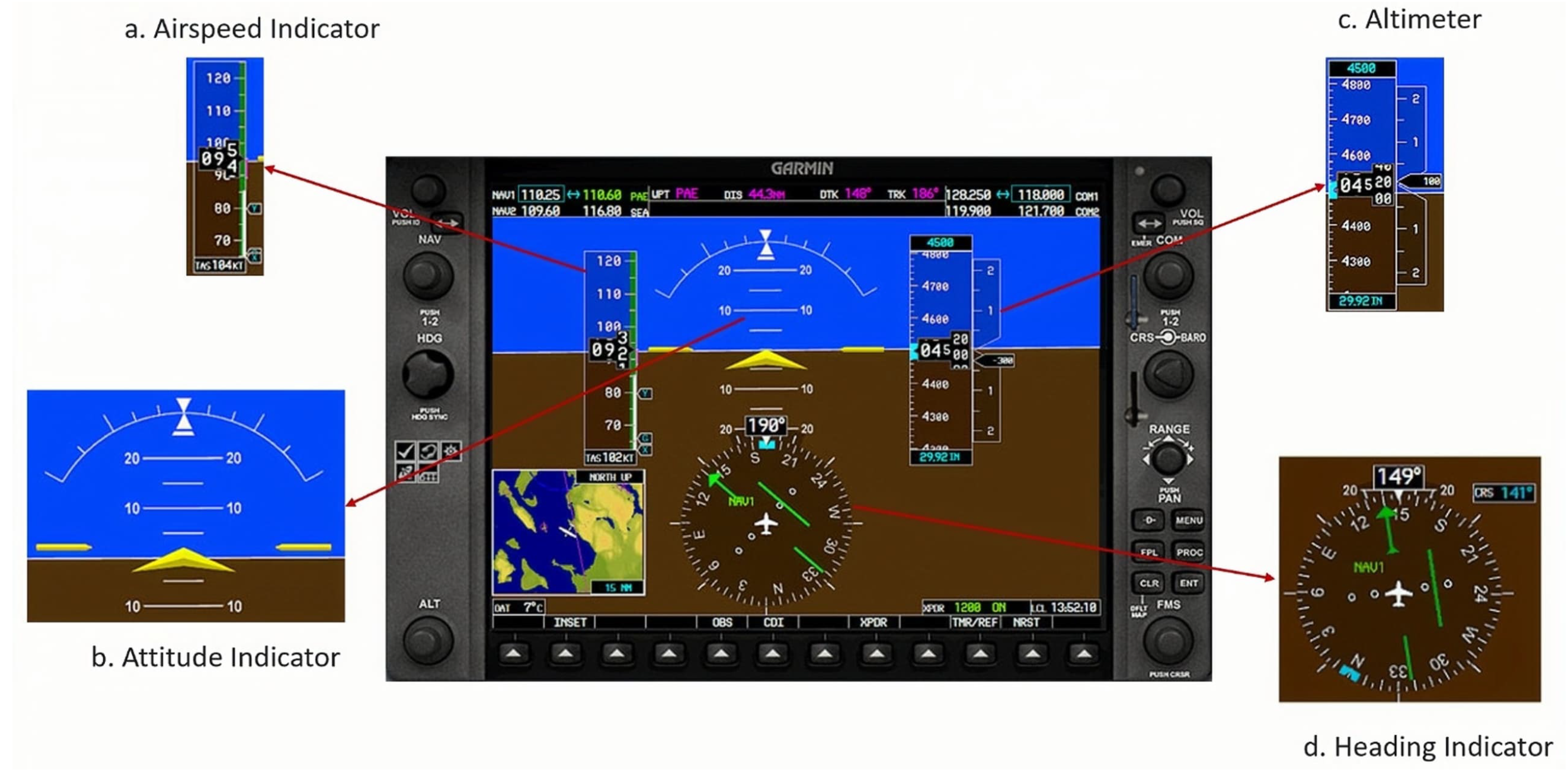
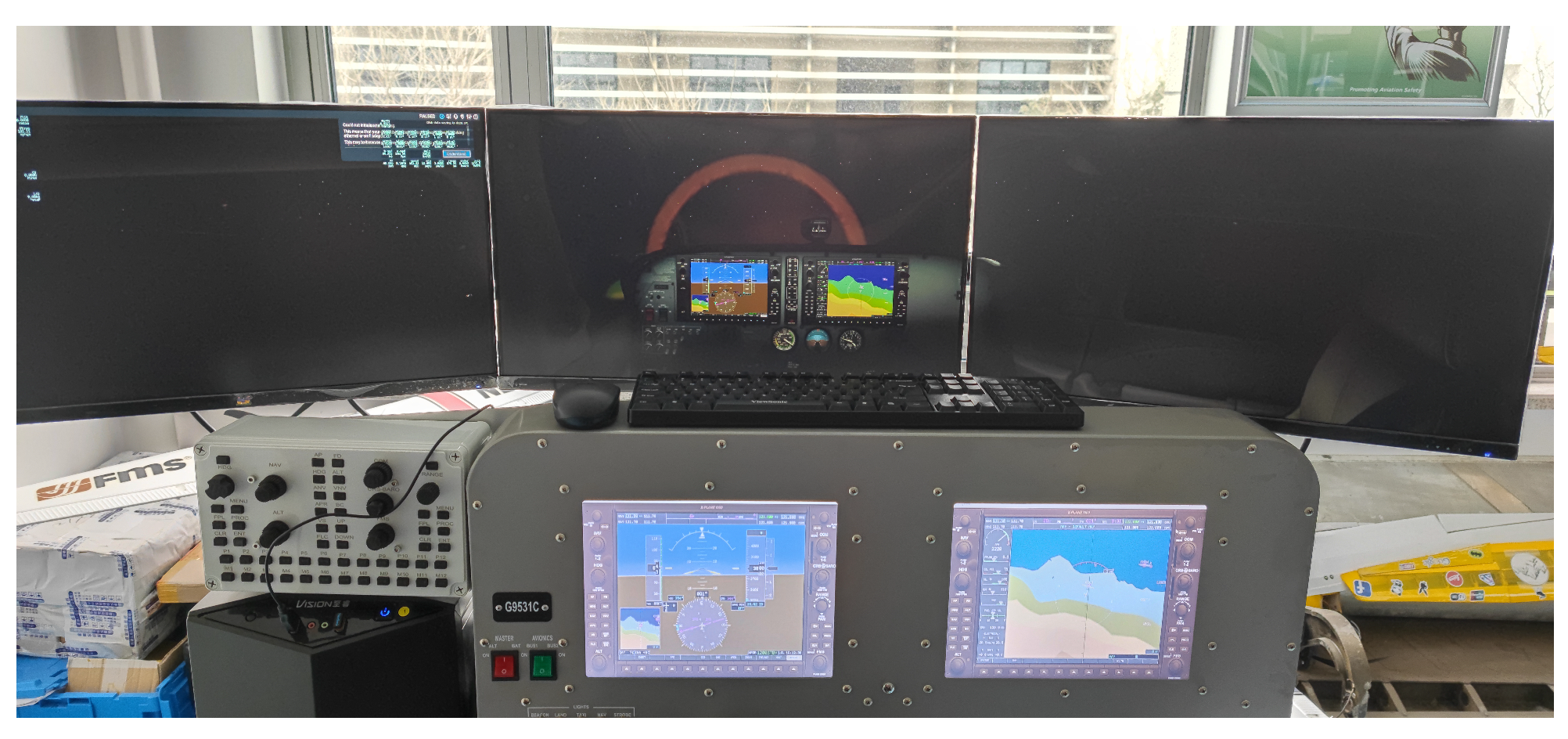
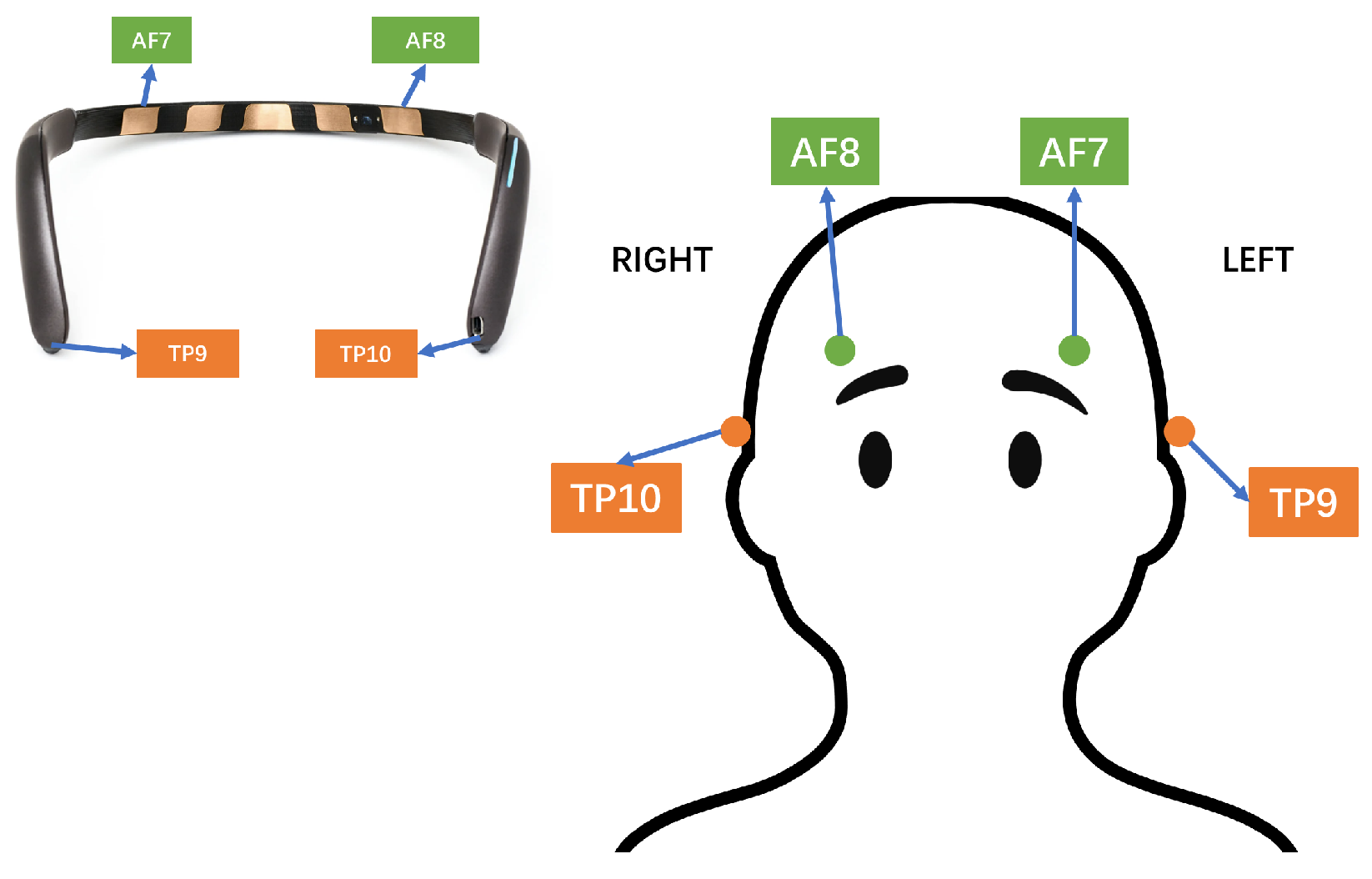

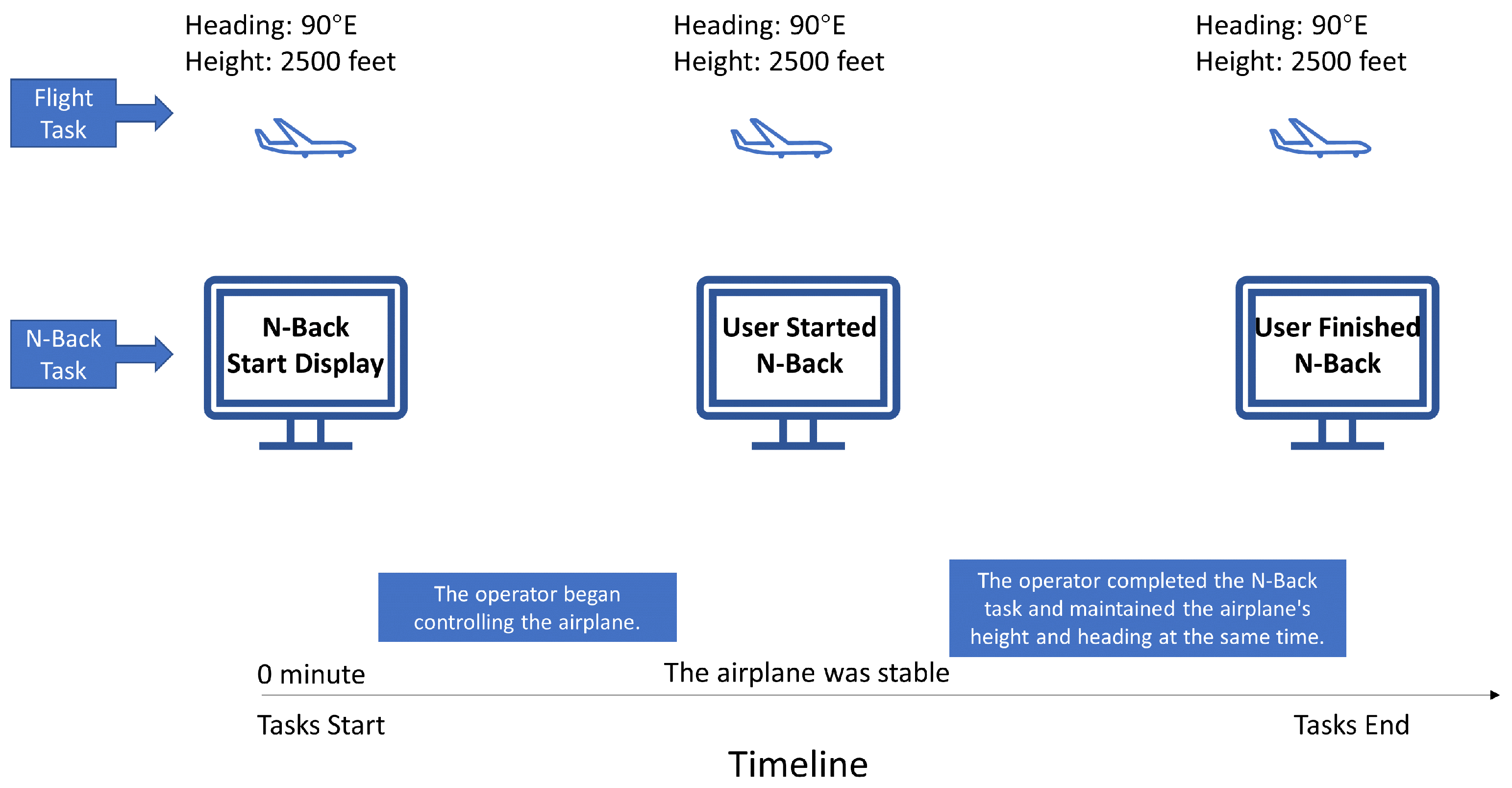

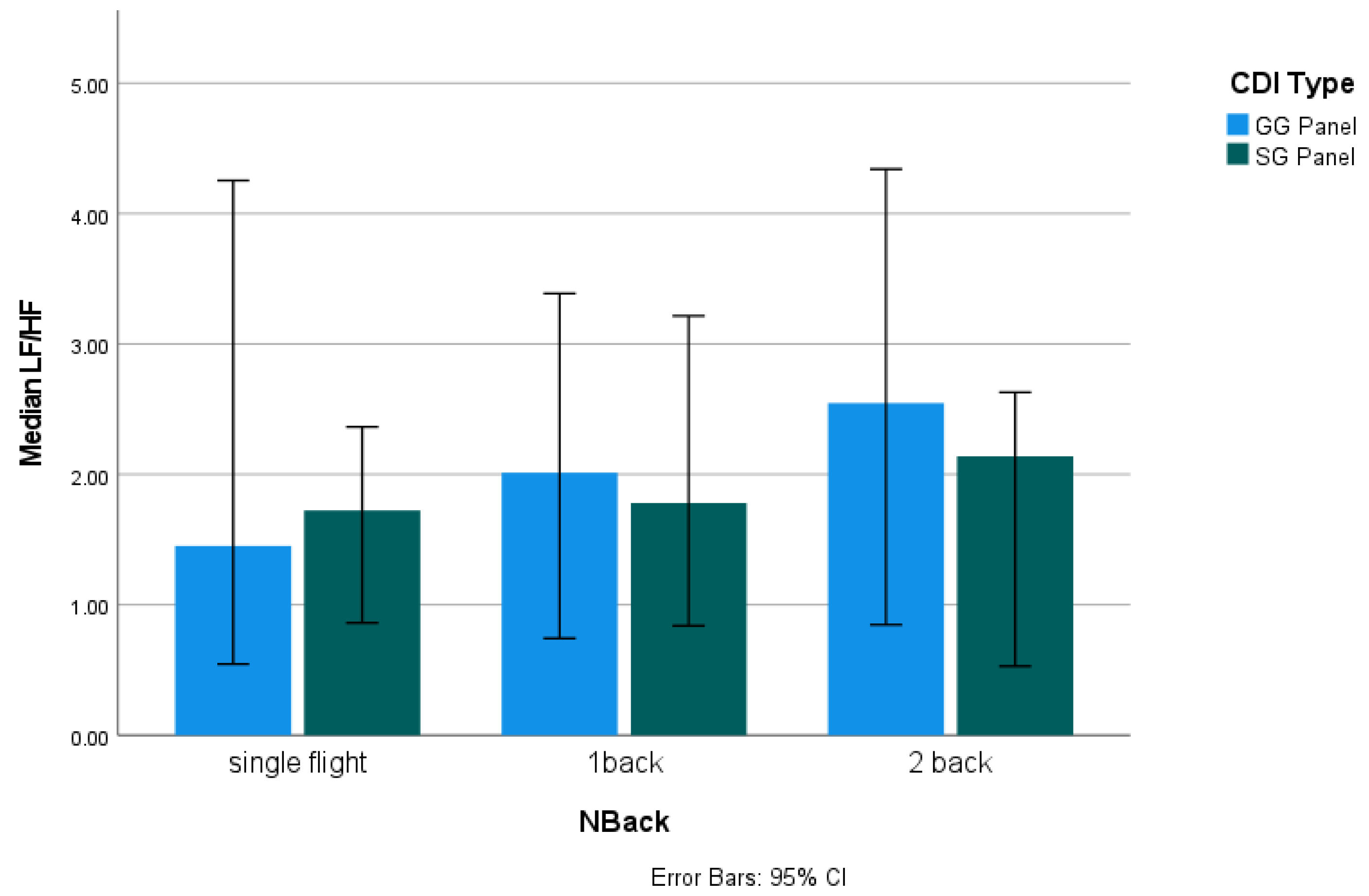


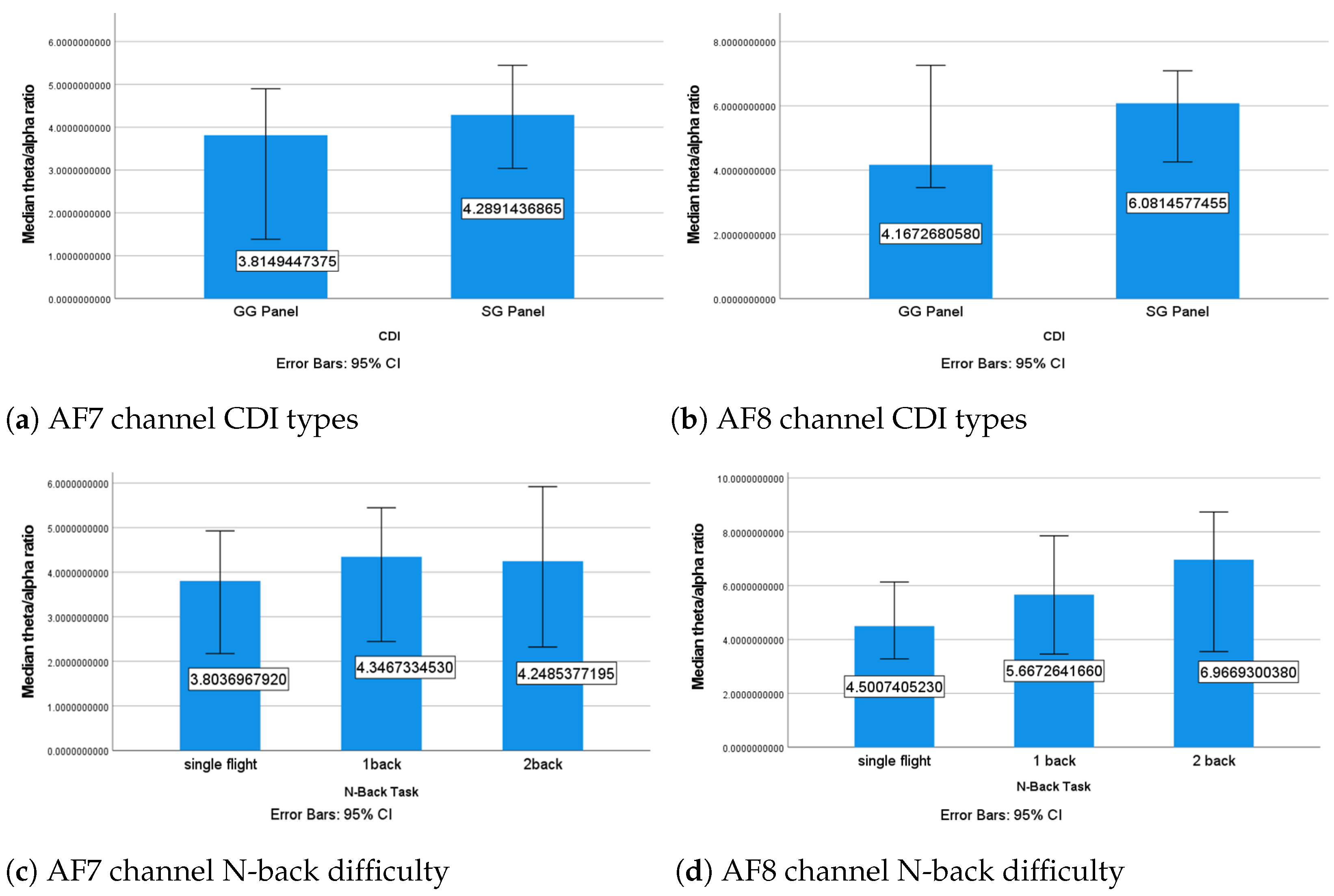

| Order of the Experiment | ||||||
|---|---|---|---|---|---|---|
| Participant | 1 | 2 | 3 | 4 | 5 | 6 |
| 1 | single-flight digital | 1 back digital | 2 back analogue | 2 back digital | 1 back analogue | single-flight analogue |
| 2 | 1 back digital | 2 back digital | single-flight digital | single-flight analogue | 2 back analogue | 1 back analogue |
| 3 | 2 back digital | single-flight analogue | 1 back digital | 1 back analogue | single-flight digital | 2 back analogue |
| 4 | single-flight analogue | 1 back analogue | 2 back digital | 2 back analogue | 1 back digital | single-flight digital |
| 5 | 1 back analogue | 2 back analogue | single-flight analogue | single-flight digital | 2 back digital | 1 back digital |
| 6 | 2 back analogue | single-flight digital | 1 back analogue | 1 back digital | single-flight analogue | 2 back digital |
| Heading (°) | Altitude (Feet) | |
|---|---|---|
| Perfect (5 points) | 90 ± 10 | 2500 ± 100 |
| Good (3 points) | 65–80, 100–115 | 2250–2400, 2600–2750 |
| Normal (2 points) | 50–65, 115–130 | 2100–2250, 2750–2900 |
| Poor (0 point) | Others | Others |
Disclaimer/Publisher’s Note: The statements, opinions and data contained in all publications are solely those of the individual author(s) and contributor(s) and not of MDPI and/or the editor(s). MDPI and/or the editor(s) disclaim responsibility for any injury to people or property resulting from any ideas, methods, instructions or products referred to in the content. |
© 2024 by the authors. Licensee MDPI, Basel, Switzerland. This article is an open access article distributed under the terms and conditions of the Creative Commons Attribution (CC BY) license (https://creativecommons.org/licenses/by/4.0/).
Share and Cite
Tang, H.; Lee, B.G.; Towey, D.; Pike, M. The Impact of Various Cockpit Display Interfaces on Novice Pilots’ Mental Workload and Situational Awareness: A Comparative Study. Sensors 2024, 24, 2835. https://doi.org/10.3390/s24092835
Tang H, Lee BG, Towey D, Pike M. The Impact of Various Cockpit Display Interfaces on Novice Pilots’ Mental Workload and Situational Awareness: A Comparative Study. Sensors. 2024; 24(9):2835. https://doi.org/10.3390/s24092835
Chicago/Turabian StyleTang, Huimin, Boon Giin Lee, Dave Towey, and Matthew Pike. 2024. "The Impact of Various Cockpit Display Interfaces on Novice Pilots’ Mental Workload and Situational Awareness: A Comparative Study" Sensors 24, no. 9: 2835. https://doi.org/10.3390/s24092835
APA StyleTang, H., Lee, B. G., Towey, D., & Pike, M. (2024). The Impact of Various Cockpit Display Interfaces on Novice Pilots’ Mental Workload and Situational Awareness: A Comparative Study. Sensors, 24(9), 2835. https://doi.org/10.3390/s24092835








